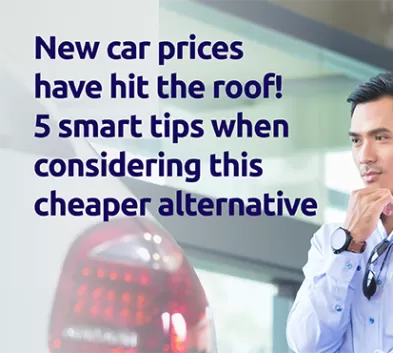New car prices have hit the roof! 5 smart tips when considering this cheaper alternative


4-minute read | Last updated: June 2023
With Certificate of Entitlement (COE)1 skyrocketing past $100,000 and inflation impacting the prices of cars, getting a brand-new ride may be something out of reach for more drivers. Experts believe that it’s unlikely that COE prices will fall back to the sub $40,000 range from just a few years ago.
1 Certificate of Entitlement (COE) is the permit needed for a vehicle to be used on the road in Singapore.
Thankfully, all is not lost. If you wish to get a car for practical reasons and are on a budget, why not consider buying used? Purchasing secondhand isn’t just better for your wallet; it’s also the smarter choice.
Let's drive into 5 handy tips on selecting an affordable and dependable used car to start your journey.
1. Figure out what’s the right car for you
The ‘right’ car depends on who you are and what you need it for. A small Japanese hatchback would do the trick if you're looking for an economic ride to commute to and from work daily. Whereas, if you need to transport the kids and in-laws around, a 7-seater SUV might be a better fit.
Assess your needs by asking yourself these questions:
- How often will I use the car?
- What distance do I typically cover?
- How many passengers will I need to accommodate?
- Will I need more boot space?
- Do I have difficulties with parking?
- What’s my budget?
There are two types of used cars in Singapore: Preferential Additional Registration Fee (PARF)2 cars and COE cars. COE cars are at least 10 years old and are cheaper than PARF cars. However, there’s a higher chance of them having maintenance issues; that'll cost you more in the long run.
2 Preferential Additional Registration Fee (PARF) cars are less than 10 years old. If owners de-registered their car within 10 years of its first registration date, they can claim a PARF rebate.
2. Know where to shop for your car
Great, you’ve decided to get a used car. Now, do you know where to get one?
Start with some desktop research before hitting the showrooms. There are plenty of online classifieds with comprehensive details and hi-res photos of the model you’re looking at. Pro tip: Shortlist those that are well-kept, with reasonable mileage and service history from a reputable dealership.
You can also find good deals from a private seller. By buying direct, you save on middlemen fees and commission. You can even secure your own bank loan and insurance for extra savings. But caution: private sellers aren't bound by the rules that dealerships must adhere to and may not entertain you if your car starts acting up down the road.
3. Look out during the test drive and pre-purchase inspection
Once you’ve made your shortlist, head down to the used car lot. Activate your senses during the test drive:
- Look for cosmetic damages to the exterior and interior.
- Listen for weird sounds from the engine and undercarriage.
- Get sniffing and note any unusual smells from the exhaust or cabin.
- Feel for strange vibrations when you go over humps or uneven surfaces.
Basically, put the car through its paces and don’t be afraid to ask the dealer questions – the more, the better.
Once the car has passed your personal inspection, request to send it for a professional one. A pre-purchase inspection from a certified mechanic will cost under $200 – but it’s money well spent. The independent mechanic can advise if you’re buying a reliable vehicle or a dud. You may also use the inspection report to negotiate a better price for your car.
Reputable dealerships should allow you to get a pre-purchase inspection as part of the buying process. Declining your request can be a red flag, a clear sign to hit the brakes, walk away and shop elsewhere.
4. Negotiate the best price possible
You’ve cherry-picked the right car that looks good, drives well, and passed the pre-purchase test. Now comes the interesting part: getting it at the right price.
Dealers have a profit margin to make. They may even add on certain ‘administrative’ fees to inflate the asking price. Always negotiate on the total price of the vehicle, inclusive of all hidden charges.
Start by making a lower offer (but no lowballs, of course). If the dealer is motivated in moving the used car off the lot, he will make a reasonable counteroffer to seal the deal.
Negotiation takes time and patience. Do not be in a hurry to make a purchase. If the dealer is unable to meet your price, pass him your phone number to contact you if he changes his mind. In the meantime, continue looking at alternatives. A better deal may just be parked in the next lot!
5. Get the right car insurance
Before collecting the keys to your new secondhand car, don’t forget to get it insured. It’s essential to protect yourself, your family members, your passengers, and other drivers with the right coverage.
You may be a safe driver but sometimes, accidents can happen that may not be your fault. The fallout from a crash can be costly and problematic. A trustworthy insurer will help you with towing, repairs, medical expenses and covering the cost of damages to other drivers.
MSIG MotorMax Plus insurance plan offers affordable, comprehensive cover with 24-hour accident assistance, reputable service from authorised workshops, and quicker claim approval to give drivers greater peace of mind on the road. Our MotorMax Plus highlights include a new-for-old car replacement in case of damage beyond repair, and loan protection of up to $100,000.
Happy driving and drive safely!



